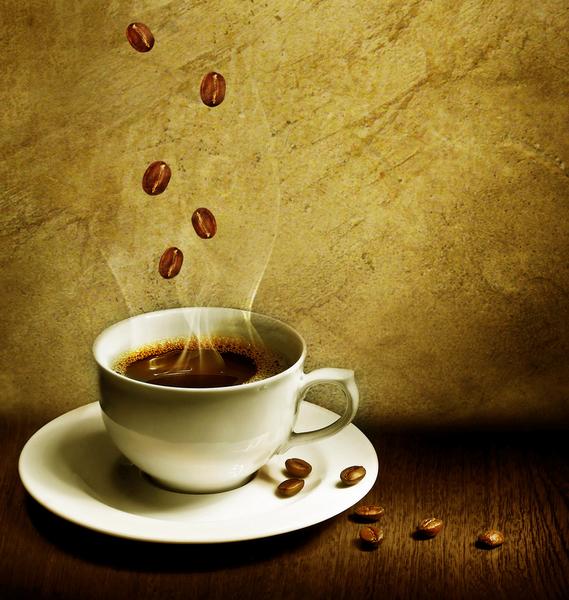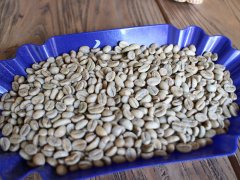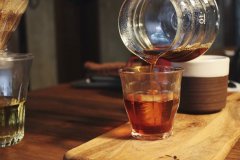Principles and principles of Coffee extraction (part I) Coffee extraction Law

Making coffee is the process of extraction, and there are a variety of extraction ways. what we need to do is to apply the extraction principle to the production to get the most perfect coffee.
Before we talk about extraction, let's popularize a little common sense:
First, coffee beans have both high-quality flavor and defective flavor.
Second, the aromatic substances of coffee will be dissolved first, and the bad substances will be dissolved later. So we are very lucky, if the aromatic substances and bad substances are dissolved at the same time, then the taste of coffee.
According to the above two points, what we need to do is to extract as many high-quality parts as possible, that is, aromatic substances, or essence, and extract as few defective substances as possible, which can also be called dregs. This process is extraction, which literally means extraction.
Then the factors that affect the extraction quality are roughly as follows: the size of the grinding powder, the amount of powder, the water temperature (the first two are a whole powder heap density), the convection (or pressure) of water, the whole time of extraction, and the ratio of coffee powder to water.
What is insufficient extraction and what is excessive extraction?
To make it easier to understand, let's give an example of magnification:
Two elements needed for the example: coffee powder and water
We took out a small ground coffee powder and extracted it with two drops of water and coffee powder to get the coffee liquid. For example, this is the perfect and best extract.
So, using a drop of water to extract, the aroma of coffee has not been fully released, this is insufficient extraction.
Similarly, use three drops of water to extract, because two drops of water have completely released all the aromatic substances of the coffee powder, and the third drop of water will extract the bad taste of the coffee powder, that is, over-extraction.
Insert a picture to rest your eyes and head.
Now you should understand the relationship between perfect extraction, underextraction and overextraction. But the whole process of extraction is much more complicated by adding the factors that previously affected the extraction.
In fact, some of these factors need to be paid attention to and summarized, while others need to be controlled as much as possible.
Why do you say that?
For example, the thickness of the powder, you can refer to the scale of the bean grinder, the particle size is also more intuitive visually, experienced friends even if changed to the bean mill also have a direct concept of the powder thickness. The amount of powder can be controlled by weighing, the level of water temperature can be controlled by temperature, extraction time and the ratio of water to powder, these are easy to control to be more accurate, so these factors are stable through continuous attempts and records.
There are two parts that are difficult to control and try to control. It is difficult to make two identical cups of coffee, which is also caused by these two factors.
One is the quality of grinding, which depends on the performance of the bean grinder. Today's technology still cannot grind coffee beans into a completely consistent coffee powder, and the difference in particle size will affect the stability of the extraction process.
The second is the convection of water, which goes back to the example of perfect extraction of two drops of water: a cup of coffee needs to extract not a coffee powder, but a pile, even if the particles are exactly the same size. we can't exchange each with two drops of water, which leads to the next factor.
The strength of convection
When we apply convection to hand flushing, there are many schools on the market: segmented water injection, one-time water injection, fast flushing, slow flushing, turning from the inside to the outside, flushing only in the center, there is also a very slow extraction of a little coffee and then diluted, and so on. The coffee produced by each genre has its own style, and the producers are often confident or even convinced of their own genre, but you may find that no matter which genre, you can make several kinds of coffee, some of which are not good at all.
To put it bluntly, the punching methods of these different schools mainly adjust the strength of convection, such as the strong convection of fast rush and the fierce exchange of water and coffee powder, which makes it easier to highlight the flavor and over-extract. The slow rush will be softer but the taste will be weaker.
So here comes the question again, how to judge whether it is not good?
The cup test has also become popular in China in recent years, and the cup test method simply means soaking coffee powder in water. The main purpose of this method is to eliminate human intervention, because there is no convection in the immersion method, and the exchange between coffee powder and water is the most consistent. Therefore, it has the most advantage in the average and stability of extraction. However, the cup test score is high and delicious beans may not be so good, while if the cup test coffee is not good, the hand test will be worse, on the whole, the cup test product is always better.
Well, if stirring several times in the middle, it is not completely stable, but on the whole, it is easy to control, but it will also affect the taste of coffee because of the number and amplitude of stirring, which is also caused by the change of convection intensity.
Back to the topic that hand flushing is difficult to do well and difficult to copy, because hand flushing uses a water column instead of a stirring rod, the overall size of the water column and the moving line of the water flow can only be controlled to a relative range, so this unstable convection is difficult to carry out uniform extraction, resulting in product feedback with completely different flavors made by different people.
Now we should understand the principle of extraction and the reason why hand punching is difficult to do well.
Therefore, for beginners, it is recommended to use equipment that gives priority to immersion, such as French kettle and Ailo pressure. In this way, as long as we pay attention to other more controllable factors, do not affect the whole extraction quality or serious extraction instability because of human intervention, so it is impossible to count whether the production method is reasonable.
Now to write this part, the novice can not continue, suitable for friends with certain hand flushing experience, according to the method explained below, the feedback will be compared, you will more clearly verify whether the extraction principle is correct, maybe your previous hand flushing process is very wrong.
The law of extraction
I think a tenable principle or rule of coffee making can be applied to all production methods, such as hand brewing, siphon, and even Italian style. If it only works well for a certain part of the coffee beans or equipment, it is a conclusion that is flawed or there is room for upgrading, or a practice that does not fully understand the principle of extraction.
As a matter of fact, the coffee circle is not big. When you point out which methods are wrong or need to be improved, then you may offend some people who believe in this way, but it will not be offended in vain, and some people will benefit and improve as a result, and I will give you a statement that will satisfy you after you try. So do not think that I am deliberately or indirectly saying who is wrong, the discussion of technology itself is like this, no matter how intense it is to make a good taste and share it with the drinkers.
The relatively controllable part of the factors affecting the extraction will be left for the next article, which focuses on convection (hand flushing).
For example, if you make it or watch a person make it by hand, his brewing, whether it is a big current or a small current,
For example, it is slow at first, then faster and faster.
Or it will remain the same very quickly from the beginning.
Or maybe it was very fast at the beginning, and then it went faster and faster.
These three methods of production have to be shot, no matter how many years of experience, as long as the above three, can be divided into types that do not understand the principle of extraction.
You might say, that's what I do, it tastes good, and that's what other people say. I would say you have a good grasp of other factors, but you can do better.
It is because the punching method mentioned above conflicts with the principle of extraction.
The aroma of coffee is dissolved first, which we explained at the beginning, so the initial extraction can be intense, resulting in the release of a large amount of aroma.
At the beginning of the rush, then the aromatic substance and defective flavor are released at the same time, and finally there is little aromatic substance left and a large number of defective flavor is released.
Therefore, the process of hand flushing must be more and more slow to avoid the release of a large number of defective flavor in the middle and back section, and the rapid flushing in the latter section will increase the appearance of defective flavor, that is, excessive extraction.
The convection of hand impact must be gradually weakened, and the later part of the production process, the more it needs to be slowed down, not accelerated.
You will see that many Japanese or Korean practitioners use very slow brewing methods: the whole process does not occur quickly, in order to avoid the emergence of defective flavor as much as possible.
You will also see some European and American counterparts, start to flush very casually and quickly, and then stop, just wait for the coffee to filter naturally, this is the inertia of convection, but also from fast to slow flushing method, can avoid the emergence of defective flavor.
The correct production method must be explained by the extraction principle and get feedback on the product. If you used the wrong method to change the method according to the extraction principle, the product must be improved, and the qualified friends will know after trying.
But whether it is always slow or slower, it is also possible to make bad coffee. For example, many peers are afraid of making deep-roasted coffee because it is always very bitter.
This is the question of when the extraction ends, that is, on the basis of understanding convection, what should be the ratio of coffee powder to water, and what is the principle?
The relationship between powder thickness and convection of water injection
What is the extraction time?
How to combine water temperature and baking degree
Will it not be bitter if it is deep baked and diluted?
Important Notice :
前街咖啡 FrontStreet Coffee has moved to new addredd:
FrontStreet Coffee Address: 315,Donghua East Road,GuangZhou
Tel:020 38364473
- Prev

The effect of Coffee Silver skin on Flavor
The surface of each raw coffee bean has a thin outer film, the silver skin treated by the sun is generally yellowish brown, and the silver skin treated by water is generally rice white, translucent, tightly wrapped in coffee raw beans, so under normal circumstances we see the color of the raw coffee bean or the bean itself, this film is called silver skin. In the coffee fruit, the outer layer of the silver skin is covered with a yellow layer.
- Next

ESPRESSO 4m Law Coffee extraction Law
The first Mistura (mixture of coffee beans) in Italy, espresso beans have to be mixed with at least five kinds of beans. For example, Erie espresso beans are composed of at least 11 kinds of coffee beans, and they also need to be fresh and roasted in Italian style, so ESPRESSO can only be pure and can not be called a single product. The second Macinino (grinding method of coffee beans)
Related
- Detailed explanation of Jadeite planting Land in Panamanian Jadeite Manor introduction to the grading system of Jadeite competitive bidding, Red bid, Green bid and Rose Summer
- Story of Coffee planting in Brenka region of Costa Rica Stonehenge Manor anaerobic heavy honey treatment of flavor mouth
- What's on the barrel of Blue Mountain Coffee beans?
- Can American coffee also pull flowers? How to use hot American style to pull out a good-looking pattern?
- Can you make a cold extract with coffee beans? What is the right proportion for cold-extracted coffee formula?
- Indonesian PWN Gold Mandrine Coffee Origin Features Flavor How to Chong? Mandolin coffee is American.
- A brief introduction to the flavor characteristics of Brazilian yellow bourbon coffee beans
- What is the effect of different water quality on the flavor of cold-extracted coffee? What kind of water is best for brewing coffee?
- Why do you think of Rose Summer whenever you mention Panamanian coffee?
- Introduction to the characteristics of authentic blue mountain coffee bean producing areas? What is the CIB Coffee Authority in Jamaica?

